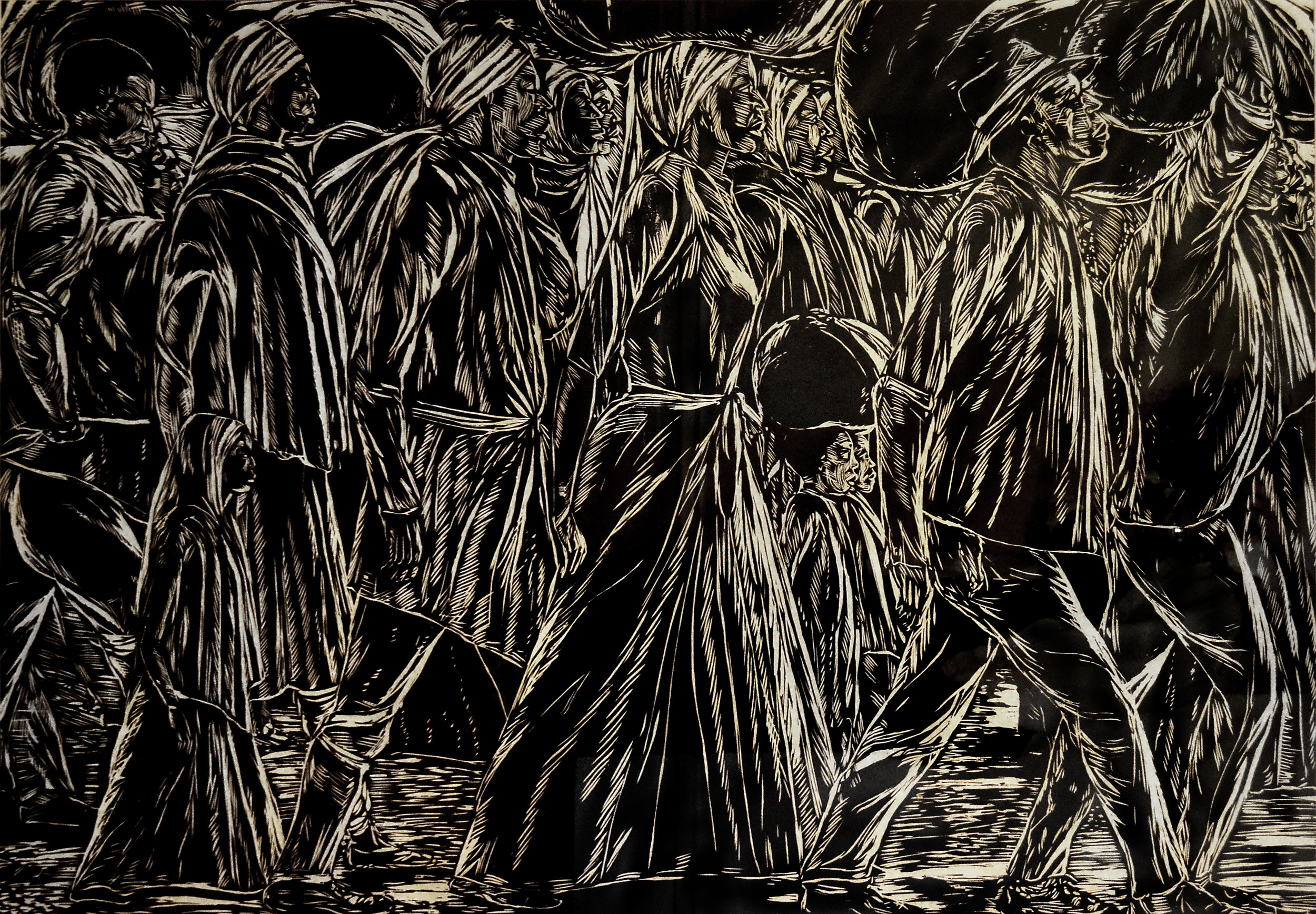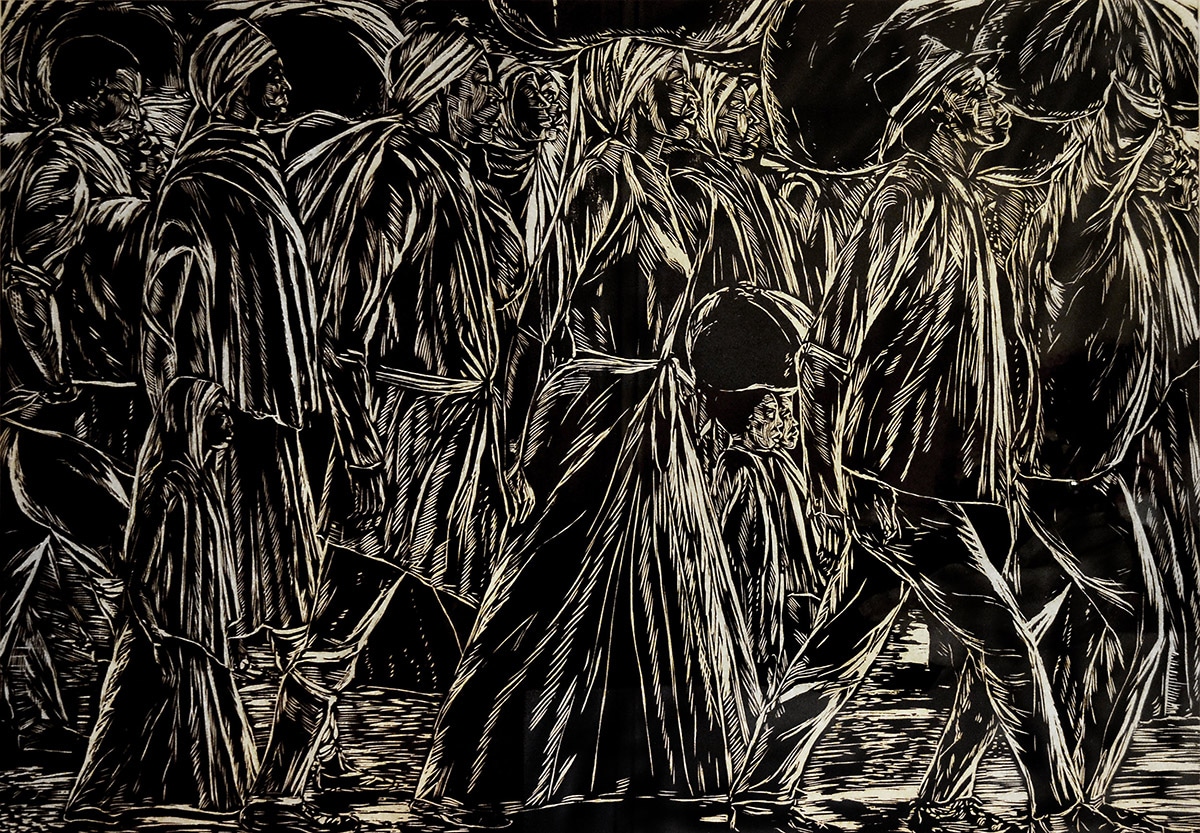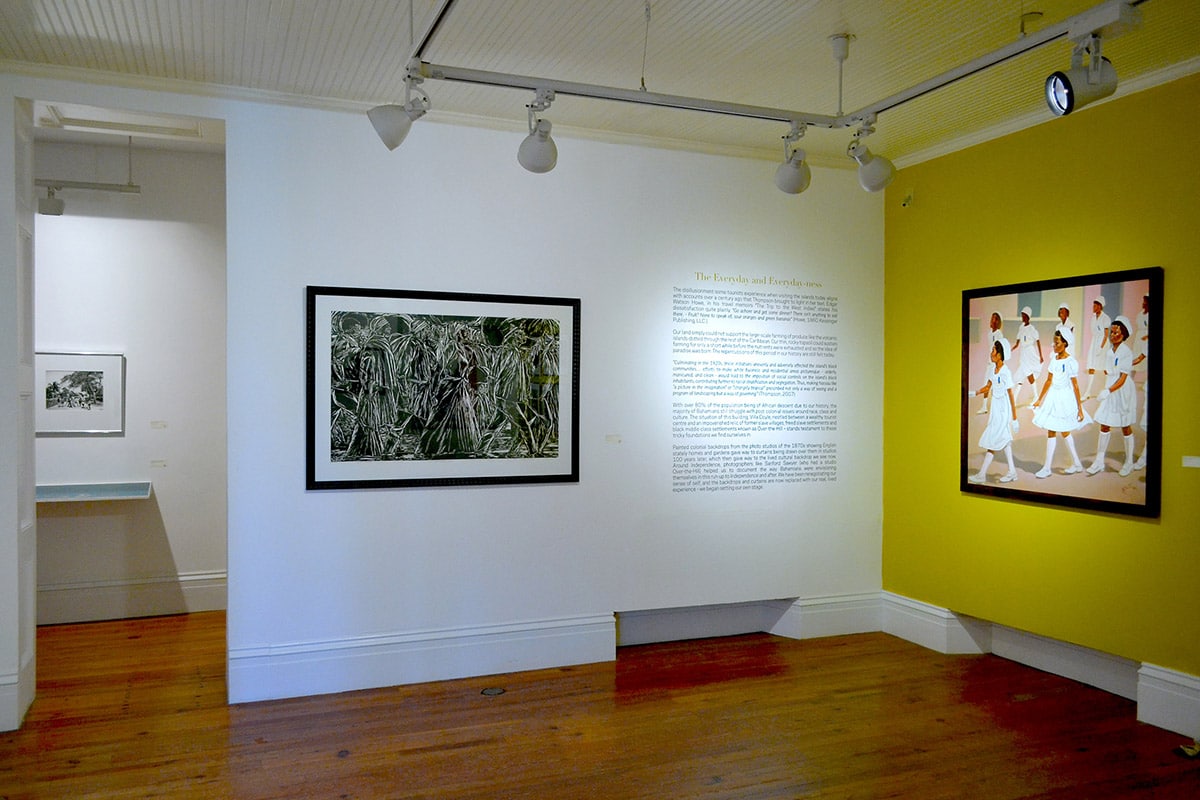
By Natalie Willis.
Maxwell Taylor’s woodcut prints are truly a thing of beauty in more ways than the obvious. The stark contrast and drama of a black and white printed image is something to behold in itself, but the way that he incorporates black bodies and the struggles they go through adds a poignant beauty of a different kind. He doesn’t make the struggle pretty, he shows people with the nobility they deserve, migrants included. Using the traditional practice of woodcut printmaking, Taylor’s “The Immigrants No.3” (c.1990) holds just as much meaning now as it did when it was first shown.
Taylor is primarily a 2D artist and although he shows a vested interest in certain traditional media (painting, drawing, printmaking) and traditional genres (Cubism in particular), the roots of his practice are not quite so conventional as one might think. Having grown up Over-The-Hill, not far from the Villa Doyle, the home of the NAGB, Taylor came of age in a time when considering a career as an artist was seen as unthinkable. We still struggle with that today, but it was seen as pure folly ‘back in the day.’
There was one art teacher who serviced all the schools in Nassau at that time, Mr Horace Wright, and they had a few short lessons and that was that, until came the “Nassau Academy of Fine Arts” under Don Russell. Things gained momentum after that and the catalytic moment for arts in The Bahamas came at the inception of the Chelsea Pottery, where Taylor met the (also) young Brent Malone and Kendal Hanna – the three of whom later became leading figures in our first generation of true Bahamian artists‘Grandfathers,’ as it were. Though Malone was often hailed as the “father of Bahamian art,” he himself had stated that the real ‘father’ was Taylor.

“The Immigrants No.3” (c1990), Maxwell Taylor, artist’s proof woodcut print on paper, 32 x 48. Part of the National Collection.
“As one of the first Bahamian artists, Maxwell is perhaps our most advanced. He is a stubbornly individualist artist that has followed his own vision, disregarding the commercial aspects of art that could have make his life so comfortable.” Brent Malone stated at the opening of a one-man exhibition at Matinee Gallery, on December 12, 1978
Taylor’s work at the time was truly groundbreaking. Here we were, a Bahamas that had been so entrenched in our own tropical ideals from this centuries-old idea of tourism, an industry that had shaped the way we viewed ourselves both pre- and post-independence and Taylor was grappling with the ‘taboo’ of expressing the struggles of our colonial and post-colonial blackness. It was uncomfortable work for certain, we don’t like to see our blemishes in the mirror, but if we don’t look, how can we know how ill we are? And there were many social ills that Taylor did his best to unpack for us.
He, along with Malone and Hanna, may have started with American and Eurocentric texts on art by those famous dead men hailed as the ‘masters’, but Taylor soon grew out of the idea of studying ‘masters’ and uncovering the double-meaning of that word for Bahamians, given our history of slavery in the islands. Taylor had no master, he had no desire to be one, he deliberately set out his practice to free us from the ugliness of our history by forcing us to confront it properly for the first time, but he did so by showing Bahamian blackness with the grace it deserved.
This is in large part due to the fact that Taylor had a vested interest in our history, and therefore the shared history we had with American blackness – and that was black diaspora history itself. Having lived many years in America, Taylor is no stranger to the intricacies of both Afro-Bahamian and Afro-American culture, what makes us similar and what makes us different. The history of people of colour on this side of the world is one that is displaced and uprooted, growing its roots over time – still, we come from the same African mother-tree and Taylor wanted to show our thorny history as a crown, painful to wear, but with the deference, reverence and regality and self-sacrificing nature it deserved. We do what we do for others to have a better life, to build, not unlike the immigrants that he depicts in this piece.

Installation view of “The Immigrants No.3” (c1990) by Maxwell Taylor, part of the National Collection as seen in the current Permanent Exhibition, “Revisiting An Eye For The Tropics”.
This region is built on migrations: of indigenous peoples, of colonizers, of slaves, of people of all different nationalities. If it wasn’t Jamaicans, it was Haitians or Cubans that were bastardized for having the ‘audacity’ to move here: countries that found their courage and strength to find independence (and in the case of Haiti, a devastatingly bloody one) so that we might find ours later down the line. And yet, what reverence have we shown to those giants whose shoulders we stand on to find and define our own freedom?
Taylor draws attention to this in crisp black and white contrast. The emotional and physical labour inherent in the faces of the men, women, and children in this show that migration is not always a choice – sometimes it is a desperate necessity. In light of the most recent set of migrations by those displaced from Hurricanes Irma and Maria, how might we better serve our regional brothers and sisters and their strong-but-exhausted shoulders that we stood upon 44 years ago, the heavy hearts that need tenderness? In a world of migrations caused less by local political post-colonial corruption, and more by apocalyptic weather, how do we do our part to lessen the shared burden of post-colonial blackness with those who feel it just as hard as we do and harder still after these disasters?
We must remember that Taylor, being an immigrant himself, having lived in the US and as a black man, no less, must have certain parallel and dark experiences that comprise the immigrant experience We abhor the terrors of being black in America but fail to recognize how we have prejudices of our own against certain kinds of blackness and nationalism here. Taylor’s work is often a very sober reminder of our history and of our need to show kindness when we were previously shown so little and when so many suffer. There is much work to be done and as woodcut printing is such an intensive and laborious process, we might want to take on the same work to chip and cut away at the unnecessary hurt and to open up space in ourselves and our country for healing – for ourselves and for those dealing with much more than we are. We can hurt and still be capable of helping others and we would do to remember the nobility of this in the way that Taylor visually elevates us as we try to uplift ourselves and each other.